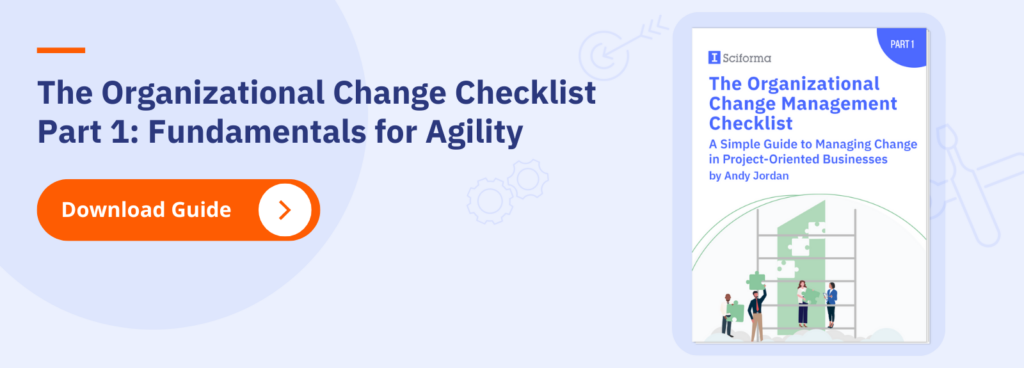Your Guide to Organizational Change Management (OCM)
No matter their industry, successful businesses and organizations all across the globe have one thing in common: managing change. Even when things are smooth sailing, change often comes in and slows the gears that keep your operations chugging. But it doesn’t have to be that way. In fact, change can offer countless benefits – if you have the right OCM strategy and software. With certain change management best practices, you can empower all employees and stakeholders to pitch in and create a system that works for everyone.
Managing Change: An Inextricable Piece of the Organizational Process

Change isn’t a scary word – or, at least, it doesn’t have to be. Any successful organization will be inherently intertwined with change, constantly evolving to meet client needs and identifying opportunities to adapt to new demands. But change doesn’t happen in a vacuum. Instead, change is a team effort.
The concept of organizational change illustrates this truth in theory and practice. When we speak about organizational change, we mean an organization’s actions to alter its components – like company culture, operational infrastructure, etc. – or internal processes.
There are two main types of organizational change to consider:
- Adaptive Changes. These are incremental changes an organization may adopt to address evolving needs over time.
- Transformational Changes. These changes are larger in scale and scope, and they typically involve significant shifts in an organization’s strategy, structure, mission, or processes.
Transformational changes are our primary focus when we consider the value of change management. Their widespread impact creates a need for clear practices, policies, and expectations. But what are some other reasons that change management is so essential?
Evolving customer expectations demand effective change
Organizational change is inevitable. That’s because customers or clients form their expectations based on change. A client’s image of a successful project is painted with hues of past experiences and future goals, which naturally change with time. Change management fills the gaps and ensures all stakeholders understand how to get from point A to point B.
Organizational change is adaptable but complex
There is no one picture of what organizational change does or should look like. But that diversity comes with a cost: simplicity. This is especially true since change is not an isolated event; one change tends to bring about another, then another, and so on. As the complexity of organizational change increases, it becomes even more crucial to ensure its functions are integrated into other areas of your organization’s strategy.
Employee engagement is precious yet underserviced
It’s well-known that employee engagement and experience are invaluable to a successful business model. Despite this, employee engagement is far lower than you might expect. A recent Gallup poll reveals that the global employee engagement level was just 23% – a record high!
Disengaged or indifferent employees will understandably not welcome or embrace change to a position that’s already frustrating, overwhelming, or unsatisfying. Sometimes, they may resist it, creating barriers to organizational success.
Employee engagement matters for more reasons than one, though. Engaged employees are happier, more collaborative, and more productive. The more engaged your workers are, the more successful your organizational efforts will be. But change can also make even the most dedicated employees feel unseen or unheard, which is why a structured approach to change is essential.
What is Organizational Change Management (OCM)?
Change has a ripple effect; it’s never an isolated incident. As a result, there’s undoubtedly a need for a flexible and structured methodology for planning, assessing, implementing, and overseeing change. That’s where organizational change management (OCM) comes into play.
Let’s break this term down into pieces. We know that change management addresses organizational goals, processes, and transitions with a precise approach that facilitates success. Change management specifically aims to create and implement strategies that help prompt, control, and demystify change.
So, what exactly is organizational change management? Put simply, it’s the ability to transition effectively and efficiently from project to operations. The best products, services, or systems in the world won’t succeed unless they can be integrated into how people work (and be accepted by those who must use them).
OCM is, in a nutshell, all the work your organization does to improve business operations. If your services are one half of the puzzle that keeps your organization alive and growing, think of OCM as the other.
Think of the organizational change management process as your “backstage” and its facilitators as your crew, readily responding to obstacles and introducing strategic solutions that keep the well-oiled ship running. Some of the practices that might go into this effort include:
- Resource training sessions
- Creating instructional materials or standard operating procedures
- Overseeing the implementation of new technology
- Troubleshooting tech-related challenges that arise
But no two ships are built the same, nor do they embark on the same missions. In this case, different needs, goals, and limitations impact what change looks like for each organization. That’s why change management varies in scope and purpose; one organization might define its OCM strategy (and implement it) very differently than another.
Imagine, for example, that a large company has been struggling to stay on top of digital communication with customers. In response to this challenge, the company’s executive team decides to implement a new customer relationship management (CRM) system into their workflow. While this change may seem small on paper, it affects employees across several departments. It may even impact other work resources or practices.
In this case, organizational change directly responds to customer needs or expectations. And, in a tech- and automation-focused world, those needs are constantly shifting. The team in our example might be tasked with introducing a new software and phasing out an old one. It might also entail training, contacting customers, and anticipating potential problems.
Change-driven transitions are often unpredictable and costly without effective organizational change management. They may also result in lower employee morale, cause project waste, and hinder skill development.
A company’s reaction to change is a critical piece of information for stakeholders and prospective employees alike. Working with an organization that is open to change and interested in actively engaging with it is far more desirable. Conversely, a lack of effective change management can also lead to organizational failure.
Learn more about organizational change management in our checklist, written by industry expert Andy Jordan:




